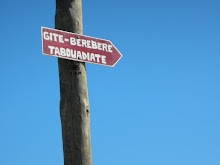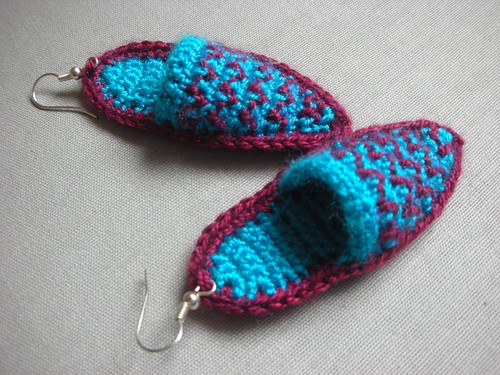
This is a story about how crochet not only influenced my work with the Al Falah Woman's Cooperative in Oulmes, Morocco, but how it became the driving force behind it.
First, a little background. When I arrived in Morocco as a Peace Corps volunteer in the fall of 2008, I thought I knew the basics of crochet. I knew how to crochet in the round and back and forth, and I could do so in single crochet (not double, half double, or triple; just single crochet). I knew how to increase and decrease (incorrectly). I had made hats, fingerless mittens, and a granny square blanket in yarn, market bags from plastic bags, and a giant copper wire installation that was my thesis project for graduating college.
I took up crocheting in Morocco near the end of our three-month Peace Corps volunteer training period (where we learned about Moroccan culture and customs, as well as how to speak Moroccan Arabic). Other volunteers started to take an interest in what I was doing and ask me to lead an introductory crochet class. It was my first time teaching crochet and when I look back on it today I laugh because it was truly the blind leading the blind.
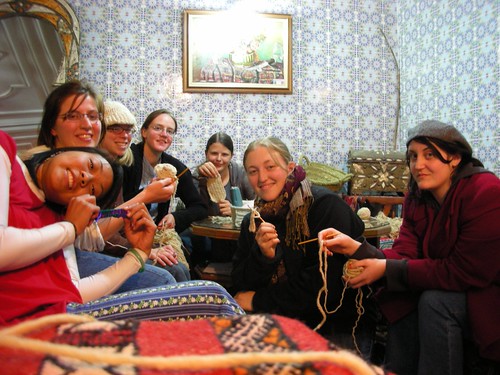
Soon afterwords, in November of 2008, we swore in as volunteers. Next, it was time to get settled into our permanent sites where we lived for the next two years.
When I first arrived in Oulmes the women of the cooperative that I was assigned to work with weren't even coming to work. Eventually a couple of girls did show up (usually one or two) and I'd sit with them for however long they stayed at the Artisana, usually just a couple of hours. Sitting there was uncomfortable. It was cold and damp (it rained nearly every day and there is no indoor heating) and the silence was deafening. I wasn't very confident in my speaking abilities yet and it was so difficult to communicate anything.
The first few months were the hardest. I had received almost no background information about this woman's group from Peace Corps, so it was up to me to try to figure out what was going on. It wasn't easy. Mostly I asked very simple questions and relied on my observation skills.
The products the cooperative had on display were so different it was striking. They had rugs woven long ago from people who were no longer involved with the co-op; ugly, heavy macromé "decor" monstrosities; large, intricately embroidered table cloths; and crochet doilies and water bottle cozies. And the projects that they would usually bring with them to work on were hand knit gloves made with the most awful acrylic yarn. Yicks! I didn't know much, but I knew that they were in desperate need of some product development.


It didn't take me long to start bringing crochet projects with me to work on while I sat with the girls, and it quickly became my best mode of communication with them. I started with something familiar, a granny square blanket. It was an easy project that took a long time, about 2 months. Finding materials was interesting. I used this terrible wool yarn, usually used for weaving carpets. It was itchy and the colors bled, but it was also a conversation starter at the co-op, mostly because of my strange yarn choice I'm sure.


Soon I decided that I needed to expand my knowledge of crochet, so I burrowed a book on needle craft (circa 1984) from the Peace Corps library. I learned three very important things from that book;
- How to make all of the crochet stitches
- How to read a pattern (and thus make motifs that were featured in the book)
- How to do tapestry crochet
The crochet flower motifs were a big hit. Fatima, the woman in the cooperative best at crochet, wanted to learn how to make each motif as fast as I could explain them. By this time it was spring and the three co-op members (Hafida, Fatima, and Achora) had recruited several girls (ages 16-22) to come to the Artisana to apprentice under them for a year, at which time they would receive their diplomas and become members themselves if they wished. After I taught Fatima how to make a motif she would then teach the younger girls. The Peace Corps calls this "Training of Trainers" (TOT) and it made me feel like I was finally doing something useful, though small as it was.

When I brought my first tapestry crochet piece to work, a round coin purse made with the same yucky acrylic yarn they use to make gloves, the ladies became very interested in what I was doing, especially Fatima. Below is Fatima's very first coin purse.
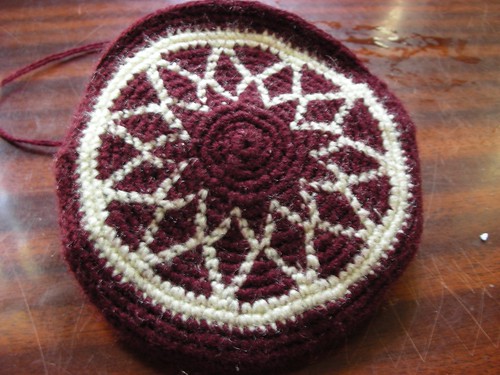
News about my tapestry crochet teaching abilities spread to other volunteers. In July, 2009, I was invited to go to Ain Chaib, down in Southern Morocco where my friend and fellow volunteer, Joy Chen, lived and worked with another woman's cooperative. There I taught two woman the technique. I also found a different type of acrylic yarn that was more suitable for making coin purses. It was a smoother and with more of a luster. When I returned, I was delighted to learn that the same yarn was available right in Oulmes!
I really wanted the women to make more of the coin purses for the upcoming Marché Maroc Craft Fair (a craft fair organized by Peace Corps volunteers) in October, 2009. This was the first craft fair that the women participated in since I came to Oulmes. However, the women only made a few coin purses, and brought mostly the hodge podge of stuff that they had since before I arrived, nearly one year prior.
Sales-wise, The craft fair was a huge disappointment. Though their prices were well below other vendors at the fair, they hardly sold a thing. But sales aren't everything, and it wasn't a total loss. As single women from a small town, Fatima and Hafida (the ones attending the fair) had the opportunity to visit a big city on their own for the first time and network with other Artisans from across Morocco, most of whom where women. As part of the event, the volunteers who organized the show brought in Moroccan consultants to talk with the Artisans about their products and teach them how to better manage their cooperatives. Below, Fatima watches over the co-op's booth at that first Marché Maroc in Fes.
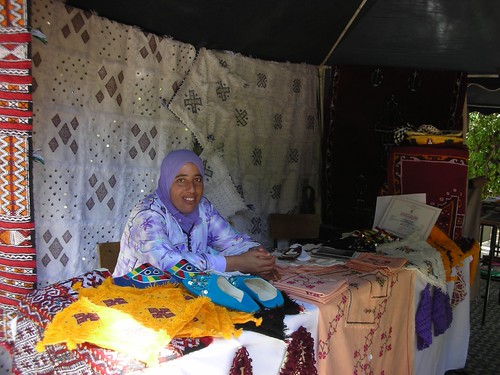
Another good thing about the women participating in the event was that they were able to see for themselves which co-ops were doing well. They realized that for them, smaller, more transportable products were the way to go. They learned that a cohesive booth was much more attractive, and about the importance of having products that appealed to tourists as well as Moroccans.
After the fair I encouraged them to make some purses for me to test out with volunteers and Peace Corps staff in the capital (Rabat) during our mid-service medical exams in December. My fellow Small Business Development volunteers critiqued the products and I was able to sell several of the purses for the co-op. A week later when I returned I gave them the feedback from the other volunteers as well as their money. It was almost twice as much as they had made at the two-day craft fair in Fes! Below are a few change purses that the women made with the nicer yarns.

Now that the ladies had a product that was small and marketable, they went to work making more for the next Marché Maroc in April, this time in Marrakesh. In addition to making the round change purses, I introduced the idea of making rectangular ones for cell phones, but it was their idea to incorporate the Amazigh letter "Z." Not only are they visually interesting, but they have an extra layer of cultural meaning.
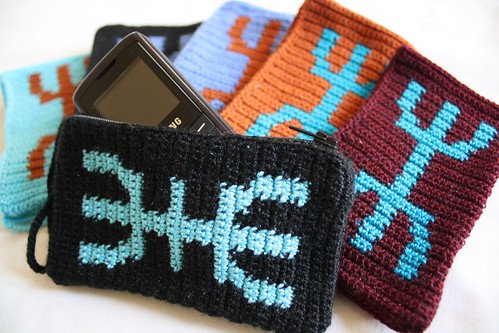
The women were always so excited about new ideas and they liked being introduced to new techniques. Whenever I suggested new products, like the i-pod Nano and i-pod Touch pouches they were always willing to give them a try. Though I would make prototypes for all of the products I introduced to them, they always took ownership of what they made, coming up with their own unique color patterns and color combinations. Below are some of the Nano and Touch cases that the women made.
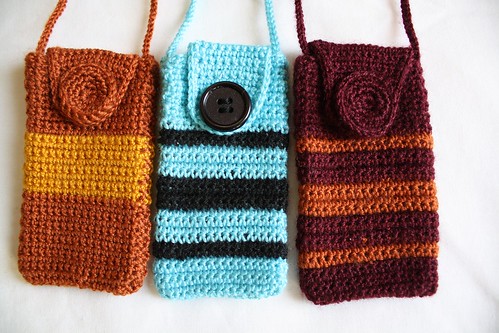

When I came up with a prototype for earrings that looked like blga (pointy Moroccan shoes), I knew that it was time to start teaching the girls how to read crochet patterns so that they wouldn't forget how to make all of these new designs [prototype for shoe at top of post]. For patterns such as the shoes and flower motifs, I drew them out in diagram form, then taught Fatima and Achora (the two main crocheters) what each symbol meant. The women didn't have names for slip stitch and half double crochet, so we decided on what we would call them, then I made a key so that they would remember what the symbols stood for. Luckily, all the coop members are literate. Below, Achora studies a diagram for a textured coin purse.

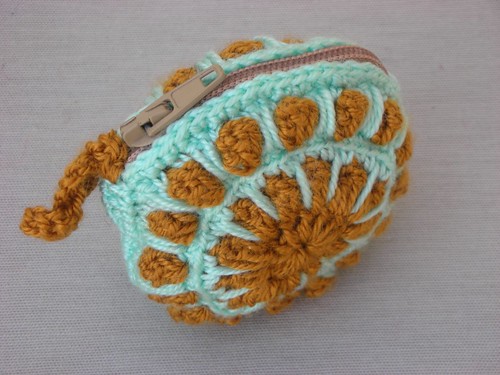
Once I developed a way for them to record their tapestry crochet designs, using mainly Roman letters in conjunction with numbers, I compiled several designs, along with samples, in a book for them. Knowing how empowered I felt after learning how to write in Arabic script well enough to get by if I needed to jot something down for the girls (which came in handy in several instances), teaching them to be crochet literate was pretty cool.
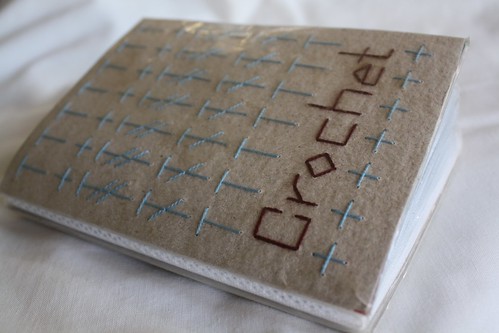
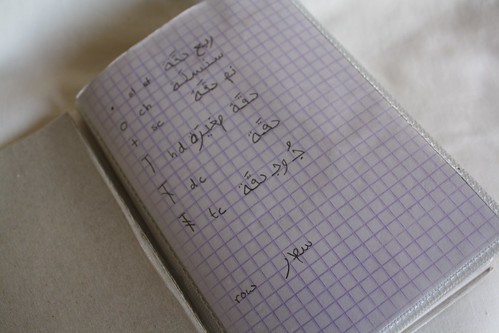
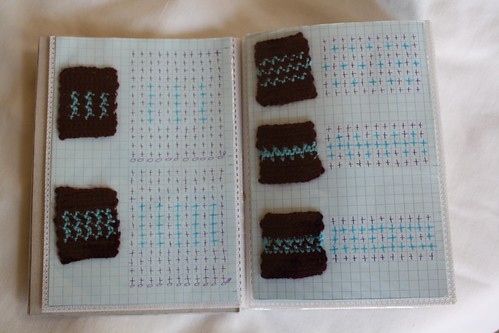
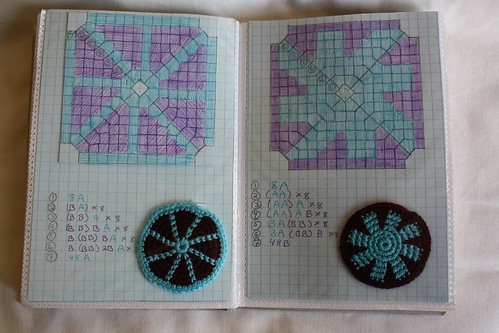
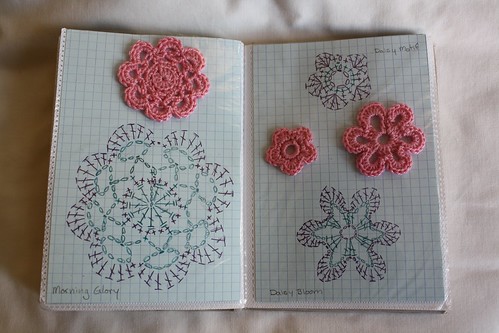
In April, 2010 they participated in the Marrakesh Marché Maroc craft fair and did very well. Again, the best part of the experience was leaving town and visiting with their growing network of crafty friends, but this time the benefits were also monetary.
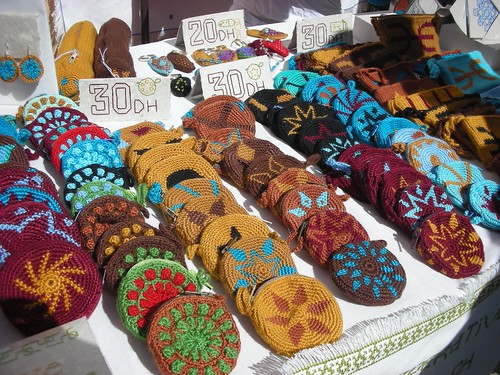

Shortly following the Marrakesh craft fair was yet another Marché Maroc in Rabat (May, 2010). Now the women were starting to pick up momentum in a major way. I could see how much they enjoyed getting out of town to meet up with their new friends, who they kept in contact with between fairs via phone. They also liked the idea of being successful and finacialy independent.
In July, 2010, I had another opportunity to teach tapestry crochet to another group of women in southern Morocco. This time I traveled to the very remote village of Oulad L'Arbia and the site of fellow volunteer and friend, April Koury. This time I taught two sisters over the course of three highly intensive days. Though the days were long and hot, the woman were determand to learn the tapestry crochet technique.
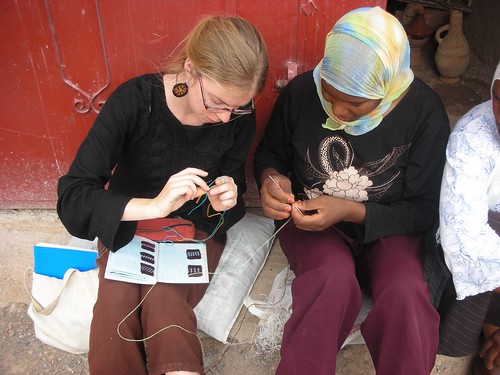
This area of Morocco is much more conserve than Oulmes. Here, woman and girls don't even go to the weekly market, let alone travel alone to the major urban areas where craft fairs take place. The education of girls in Oulad L'Arbia is also not what it is in Oulmes. One of the sisters didn't even know how to count. I'm really proud of the progress they both made over those three days. Not only did they learn the technique (which involves counting), but they learned how to read and write tapestry crochet patterns (like the ones shown above) as well!
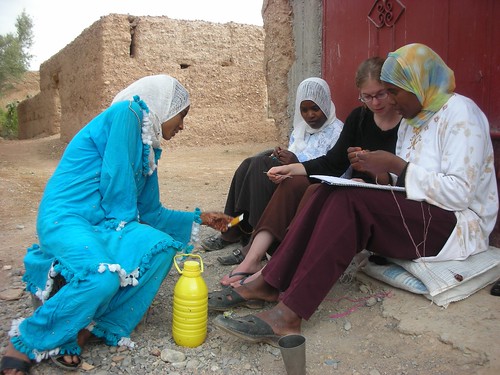
There was another Marché Maroc scheduled for October, 2010 again in Fes, but unfortunately the event was cancelled. Luckily, the Oulmes ladies would be able to go to the second Marrakesh Marché in early December, 2010, shortly after I finished my Peace Corps Service. I was helping them prepare for the fair right up until I left the country.
Though crochet was just one of many projects that occupied my time as a volunteer, it was probably the most important because it was what helped me to feel accepted and respected among this amazing group of women.
Believe it or not, there are some people who actually think that knowing how to do traditional crafts such as crochet, knitting, embroidery, etc. is a waste of time and a step in the wrong direction for the female sex. But to all those nay sayers I say that you can't judge a woman until you've crocheted a mile of yarn with her hook.

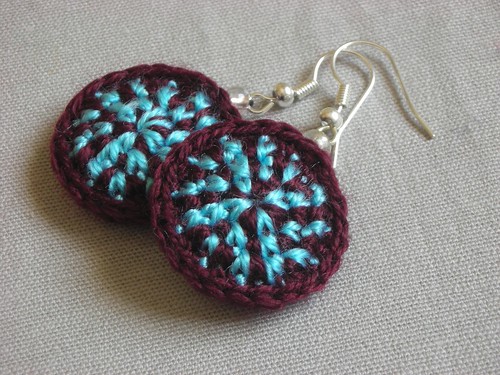

Above three; prototypes and motif samples by Emily Lindberg
